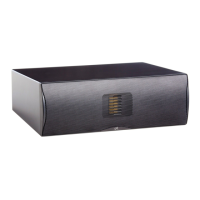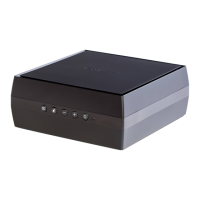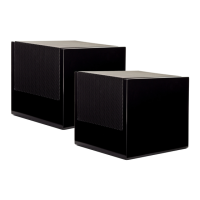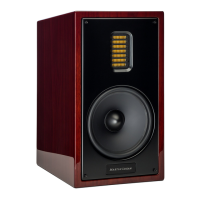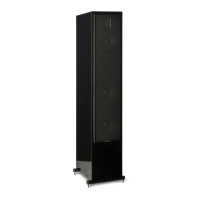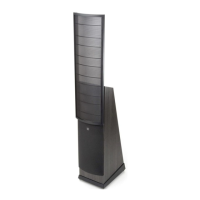towards the listening area. You will notice the tonal bal-
ance and imaging changing. You will notice that as the
speakers are toed-in, the system becomes slightly brighter
than when toed-out. This design gives you the flexibility
to compensate for a soft or bright room.
Generally it is found that the ideal listening position is with
the speakers slightly toed-in so that you are listening to the
inner third of the curved transducer section. A simple, yet
effective method to achieve equal toe-in involves sitting at
the listening position, holding a flashlight under your chin
and pointing it at each speaker. The reflection of the flash-
light should be within the inner third of the panel (figure 4).
Tilting the Speakers Backwards and Forwards—As the
diagrams show in the Dispersion Interactions section of
this manual (page 13), the vertical dispersion is directional
above and below the stator panel itself. In some instances,
if you are sitting close to the floor, slight forward tilting of
the speakers can enhance clarity and precision.
Imaging—In their final location your CLX speakers may
have a stage width somewhat wider than the speakers
themselves. On well-recorded music, the instruments can
extend beyond the outer edges of each speaker (left and
right), yet a vocalist should appear directly in the middle.
The size of the instruments should not be too large or too
small, subject to the intent and results of each unique
audio recording.
Additionally, you should find good clues to stage depth
and height. Make sure that the vertical alignment, dis-
tance from the front wall, and toe-in is exactly the same
for both speakers. This will greatly enhance the quality of
your imaging.
Bass Response—Your bass response should be tight and
well defined. Kick-drums should be tight and percussive.
String bass notes should be uniform and consistent the run
without booming or thudding. Bass response should not
be ‘one note’ or be too heavy.
Tonal Balance—Voices should be natural and full.
Cymbals should be detailed and articulate yet not bright
and piercing. Pianos should have a nice transient char-
acteristic and deep tonal registers. If you are not hearing
these traits, read the section on Room Acoustics (pages
11–12). This will give you clues on how to get closer to
these ideal qualities.
Final Placement
After the full break in period, obtaining good wall treat-
ments, and the proper toe-in angle, begin to experiment
with the distance from the wall behind the speakers.
Move your speaker slightly forward into the room. What
happened to the bass response? What happened to the
imaging? If the imaging is more open and spacious and
the bass response is tightened, that is a superior position.
Move the speakers back six inches from the initial setup
position and again listen to the imaging and bass response.
There will be a position where you will have pinpoint
imaging and good bass response. That position is the point
of the optimal placement from the front wall.
Now experiment with placing the speakers farther apart.
As the speakers are positioned farther apart, listen again,
not so much for bass response but for stage width and
good pinpoint focusing.
Check and adjust toe-in each time you move the speakers.
Your ideal listening position and speaker position will
be determined by:
• Tightness and extension of bass response
• Width of the stage
• Pinpoint focusing of imaging
Once you have determined the best of all three of these
considerations, you will have your best speaker location.
Setup and Placement 9
Figure 4. Flashlight toe-in technique.
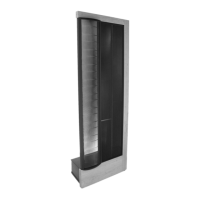
